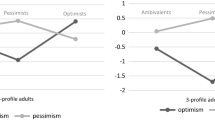Abstract
Weighted least-squares confirmatory factor analysis and exploratory factor-analytic procedures were used to assess the dimensionality of three self-report instruments designed to measure optimism and pessimism: the Life Orientation Test (LOT), the Hopelessness Scale (HS), and the Optimism and Pessimism Scale (OPS). The LOT was found to be bidimensional, the HS unidimensional, and the OPS multidimensional. The HS was interpreted as measuring a unipolar pessimism dimension. Factor analyses performed on an item subset from the OPS that fit the definition of optimism and pessimism as generalized outcome expectancies also supported the two-dimensional model of optimism and pessimism. Differential correlations between separate optimism and pessimism indices and a measure of psychological stress provided partial further support for a two-dimensional model of optimism and pessimism.
Similar content being viewed by others
References
Abramson, L. Y., Metalsky, G. I., & Alloy, L. B. (1989). Hopelessness depression: A theory-based subtype of depression.Psychological Review, 96, 358–372.
Bandura, A. (1986).Social foundations of thought and action: A social cognitive theory. Englewood Cliffs, NJ: Prentice-Hall.
Beck, A. (1987). Cognitive models of depression.Journal of Cognitive Psychotherapy: An International Quarterly, 1, 5–37.
Beck, A. T., Steer, R. A., Kovacs, M., & Garrison, B. (1985). Hopelessness and eventual suicide: A 10-year prospective study of patients hospitalized with suicidal ideation.American Journal of Psychiatry, 142, 559–563.
Beck, A. T., Weissman, A., Lester, D., & Trexler, L. (1974). The measurement of pessimism: The Hopelessness Scale.Journal of Consulting and Clinical Psychology, 42, 861–865.
Bollen, K. A. (1989).Structural equations with latent variables. New York: Wiley.
Dember, W. N., & Brooks, J. (1989). A new instrument for measuring optimism and pessimism: Test-retest reliability and relations with happiness and religious commitment.Bulletin of the Psychonomic Society, 27, 365–366.
Dember, W. N., Martin, S., Hummer, M. K., Howe, S., & Melton, R. (1989). The measurement of optimism and pessimism.Current Psychology: Research and Review, 8, 102–119.
Derogatis, L. R. (1980).The Derogatis Stress Profile (DSP): A summary report. Baltimore: Clinical Psychometric Research.
Derogatis, L. R. (1987). The Derogatis Stress Profile (DSP): Quantification of psychological stress.Advances in Psychosomatic Medicine, 17, 30–54.
Hattie, J. (1985). Methodology review: Assessing unidimensionality of tests and items.Appled Psychological Measurement, 9, 139–164.
Hulin, C. L., Drasgow, F., & Parsons, C. K. (1983).Item response theory: Application to psychological measurement. Homewood: Dow-Jones Irwin.
Jöreskog, K. G., & Sörbom, D. (1989).LISREL 7: A guide to the program and applications. Chicago: SPSS, Inc.
Jöreskog, K. G., & Sörbom, D. (1990).SPSS LISREL 7 and PRELIS: User's guide and references. Chicago: SPSS, Inc.
Lazarus, R. S., & Folkman, S. (1984).Stress, appraisal, and coping. New York: Springer.
Marshall, G. N., Wortman, C. B., Kusulas, J. W., Hervig, L. K., & Vickers, R. R. (1992). Distinguishing optimism from pessimism: Relations to fundamental dimensions of mood and personality.Journal of Personality and Social Psychology, 62, 1067–1074.
McDonald, R. P. (1970). The theoretical foundations of principal factor analysis, canonical factor analysis, and alpha factor analysis.British Journal of Mathematical and Statistical Psychology, 23, 1–27.
McDonald, R. P. (1985).Factor analysis and related methods. Hillsdale, NJ: Erlbaum.
Natali-Alemañy, R. M. (1991).Moods, coping, and perception of daily life events: Are these factors related to optimism and pessimism? Unpublished doctoral dissertation., University of Cincinnati, Cincinnati, OH.
Roznowski, M. A., Tucker, L. R., & Humphreys, L. G. (1991). Three approaches to determining the dimensionality of binary items.Applied Psychological Measurement, 15, 109–127.
Scheier, M. F., & Carver, C. S. (1985). Optimism, coping, and health: Assessment and implications of generalized outcome expectancies.Health Psychology, 5 219–247.
Scheier, M. F., & Carver, C. S. (1987). Dispositional optimism and physical well-being: The influence of generalized expectancies on health.Journal of Personality, 55, 169–210.
Smith, T. W., Pope, M. K., Rhodewalt, R., & Poulton, J. L. (1989). Optimism, neuroticism, coping, and symptom reports: An alternative interpretation of the Life Orientation Test.Journal of Personality and Social Psychology, 56, 640–648.
Steiger, J. H. (1980). Tests for comparing elements of a correlation matrix.Psychological Bulletin, 87, 245–251.
Steiger, J. H. (1987).MULTICORR (Version 2.4). Unpublished document. University of British Columbia, Vancouver.
Young, M. A., Halper, I. S., Clark, D. C., Scheftner, W., & Fawcett, J. (1992). An item response theory evaluation of the Beck Hopelessness Scale.Cognitive Therapy and Research, 16, 579–587.
Author information
Authors and Affiliations
Additional information
The authors wish to thank Luz C. Emiliano for her steadfast assistance in data collection and management. The participation of the third author was made possible by a Postdoctoral Scholarship from the Ministry of Education and Science of Spain.
Rights and permissions
About this article
Cite this article
Chang, E.C., D'Zurilla, T.J. & Maydeu-Olivares, A. Assessing the dimensionality of optimism and pessimism using a multimeasure approach. Cogn Ther Res 18, 143–160 (1994). https://doi.org/10.1007/BF02357221
Issue Date:
DOI: https://doi.org/10.1007/BF02357221




